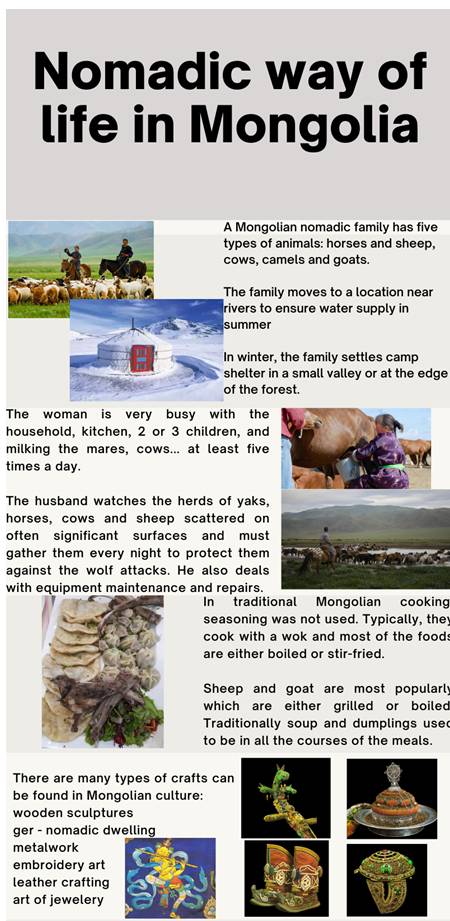Choose an interesting photo of your family
or friends.
Hãy nhập câu hỏi của bạn vào đây, nếu là tài khoản VIP, bạn sẽ được ưu tiên trả lời.


1,
Everyday life: The life of Mongolian is punctuated by caring animals. A Mongolian nomadic family has five types of animals: horses and sheep for hot season and cows, camels and goats for cold season.
Several times during the year, according to the needs of livestock and pasture conditions, nomadic families move their yurts.
In summer, the nomadic family will favor a location near a river, to ensure water supply for the family and herds, and good pastures.
In winter, the priority is given to protection against the intense cold of Mongolian winter, and the family settles its "winter" camp sheltered from the wind in a small valley or at the edge of a forest.
The woman is very busy with the household, kitchen, 2 or 3 children, and milking the mares, cows... at least five times a day.
The husband watches the herds of yaks, horses, cows and sheep scattered on often significant surfaces and must gather them every night to protect them against the wolf attacks, frequent in Mongolia.
He also deals with equipment maintenance and repairs.
Ways of cooking: In traditional Mongolian cooking, seasoning was not used; although salt was there a long time and it is used it even in tea! Typically, they cook with a wok and most of the foods are either boiled or stir-fried.
Since a lot of livestock is raised in Mongolia, it is no mystery that Mongolian cuisine revolves around them. Sheep and goat are most popularly which are either grilled or boiled. Traditionally soup and dumplings used to be in all the courses of the meals, without which, it was regarded to be incomplete.
There are many types of crafts can be found in Mongolian culture: wooden sculptures, ger - nomadic dwelling, metalwork, embroidery art, leather crafting, art of jewelery.
The traditional masterpiece of Mongolian is the urtyn duu accompanied with the morin-khurr. Most famous Mongolian dance are: Jinai dance (milking dance), the Caihong dance (rainbow dance), the Zhongwan dance (bowl dance), the Kuaizi dance (chopsticks dance), and the Andai dance
There are lots of festival in Mongolia but these are the most well-known one: Tsagaan Sar (Lunar New Year); Khovsgol Ice Festival; Naadam Festival; Gongoriin Bombani Hural; Ölgii Eagle Festival.
2,

3,
Hello everyone, today our group will introduce the nomadic way of life in Mongolia. The life of Mongolian family depends on the healths of herds and is punctuated by caring for animals.
Traditionally, a Mongolian nomadic family has five types of animals: horses and sheep, cows / yaks, camels and goats.
Several times during the year, according to the needs of livestock and pasture conditions, nomadic families move their yurts.
In summer, the nomadic family will favor a location near a river, to ensure water supply for the family and herds, and good pastures.
In winter, the priority is given to protection against the intense cold of Mongolian winter, and the family settles its "winter" camp sheltered from the wind in a small valley or at the edge of a forest.
The woman is very busy with the household, kitchen, 2 or 3 children, and milking the mares, cows... at least five times a day.
The processing of dairy products (cream, yogurt, liquor, milk, cheese ...) takes a long time as well.
The husband watches the herds of yaks, horses, cows and sheep scattered on often significant surfaces and must gather them every night to protect them against the wolf attacks, frequent in Mongolia. He also deals with equipment maintenance and repairs.
In traditional Mongolian cooking, seasoning was not used; although salt was there a long time and it is used it even in tea! Typically, they cook with a wok and most of the foods are either boiled or stir-fried. Sheep and goat are most popularly which are either grilled or boiled. Traditionally soup and dumplings used to be in all the courses of the meals.
There are many types of crafts can be found in Mongolian culture: wooden sculptures, ger - nomadic dwelling, metalwork, embroidery art, leather crafting, art of jewelery.
The traditional masterpiece of Mongolian is the urtyn duu accompanied with the morin-khurr. Most famous Mongolian dance are: Jinai dance (milking dance), the Caihong dance (rainbow dance), the Zhongwan dance (bowl dance), the Kuaizi dance (chopsticks dance), and the Andai dance
There are lots of festival in Mongolia but these are the most well-known one: Tsagaan Sar (Lunar New Year); Khovsgol Ice Festival; Naadam Festival; Gongoriin Bombani Hural; Ölgii Eagle Festival. Thanks for listening.

Which invention makes your life easier/ more interesting?
(Phát minh nào làm cho cuộc sống của bạn dễ dàng hơn/ thú vị hơn?)
It's a mobile phone.
(Là điện thoại di động.)
What can you do with it? How does it make life easier/ more interesting for you?
(Nó có thể làm gì cho bạn? Nó làm cho cuộc sống của bạn dễ đang hơn/ thú vị hơn như thế nào?)
With a mobile phone I can get information, study from home, listen to music, watch movies, play games, take photos, shop for anything,...
(Với điện thoại di động tôi có thể nhận thông tin, học tại nhà, nghe nhạc, xem phim, chơi trò chơi, chụp ảnh, mua sắm bất cứ thứ gì,...)
What else can you do? How else does it make life easier/ more interesting?
I can also book flights, hotels, order food and drink, and communicate with friends all over the world.
(Tôi cũng có thể đặt vé máy bay, khách sạn, gọi đồ ăn và đồ uống, và giao tiếp với bạn bè trên khắp thế giới.)


REFER
Dear Dad and Mom,
I arrived in Da Lat late in the morning, about at twelve o'clock. When I came, the weather was fine and the day was beautiful. I enjoyed the cool and fresh mild air although it was nearly midday.
Uncle Tuan met me at the bus station and took me home on his motorcycle. I visited many beautiful places in Da Lat such as the Flower Garden, the Chinese Pagoda and the Love Valley.
Yesterday Uncle Tuan took me to the Prenn and Dambri Falls. The falls are very beautiful and impressive. I've never seen such beautiful and fascinating sights.
This morning, we went to visit the village of the tribe Lat. They live in small cottages. They were very friendly and they invited us to drink their traditional drink, "cần" alcohol.
For meals, we eat a lot of local nice vegetables and the tasty fruit of Da Lat, fresh strawberries.
The atmosphere here is very lovely and peaceful. I feel relaxed myself with the nature. I'm enjoying myself very much. I bought some fruits and some souvenirs. I also had some photos of places I visited to show you about my trip. I'm planning to go home next Thursday. Uncle and Aunt Huy asked me to give you their regards.
Stop for now. See you on Thursday.
Your son,
An

family